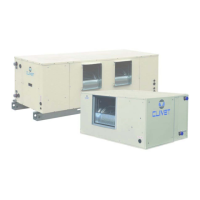
Do you have a question about the CLIVET CF Series and is the answer not in the manual?
| Brand | CLIVET |
|---|---|
| Model | CF Series |
| Category | Air Conditioner |
| Language | English |
Details on the unit's identification label, including type, serial number, and manufacturing data.
Unique identifier for tracing machine features, components, and specific unit details.
Lists typical reasons for unit operational interruption, such as filter issues or valve closures.
Guidelines for manual usage, storage, and requirements for qualified technicians.
Covers unit installation, power supply conformity, and packaging safety precautions.
Procedures for maintenance, handling faults, and authorized repairs to ensure safety.
Information on unit modifications, designated purpose, and manufacturer's right to update data.
Details on ISO 9001 quality system and CE mark compliance for Clivet products.
Identifies general hazards and specific danger zones around the unit for authorized personnel.
Details risks associated with improper unit handling and installation procedures.
Highlights hazards related to electrical connections and moving components.
Describes potential risks from defects in water system components like pipelines and valves.
Procedure for checking the unit for damage or deficiencies upon delivery.
Recommendations for proper unit storage conditions to maintain integrity.
Instructions and considerations for safe unit handling and maneuvering.
Steps and precautions for safely removing unit packaging.
Factors to consider when installing air-conditioning systems, including location and connections.
Importance of maintaining specific spaces around the unit for operation and maintenance.
Specific recommendations for the physical placement of the unit for optimal performance.
Principles for water piping design, support, and anti-vibration measures.
Guidance on installing valves, indicators, bleeding cocks, and tube insulation.
Procedures for freeze prevention, system emptying, and expansion tank requirements.
Instructions for condensate drain setup and water heating coil connections.
Factors for designing and creating air ducts for treated air, including pressure drops.
Guidelines for duct surfaces, insulation, and air distribution for optimal room comfort.
Electrical line requirements, personnel qualifications, and data line precautions.
Information on unit power supply, electrical data, and mains connection.
Step-by-step instructions for safely connecting the unit to the main power supply.
Criteria for selecting an ideal location for the room thermostat for accurate readings.
Lists locations that should be avoided for thermostat installation to prevent interference.
Instructions for setting the jumper for serial communication.
Guidelines for connecting units in a bus topology via RS485.
Recommendations for cable shielding and conductor specifications for RS485.
Essential checks for preliminary, aeraulic, water, and electrical systems before operation.
Checks on voltage, phase balance, and current absorption during operation.
Verifying the activation of remote inputs like ON-OFF.
Procedure for adjusting the desired temperature set-points.
Process for checking and calibrating air flow rates against system characteristics.
Methods for managing the unit locally via thermostat or remotely via RS485.
Explanation of unit operation modes and water temperature conditions.
Description of Automatic, Manual, and ECO modes.
How the unit switches modes in 2-pipe systems based on water temperature.
Detailed transition criteria for automatic mode based on temperature.
How valves function in automatic and ECO modes.
Overview of the HID-T2/T3 thermostat's user interface and basic functions.
How to modify set-points and view ambient temperature/humidity.
Changing operational modes and activating the ECO energy-saving feature.
Controlling fan speed manually and managing the air supply shutter.
Table listing alarm codes and their meanings for troubleshooting.
Procedure for accessing and adjusting unit parameters via the thermostat.
Detailed list of thermostat parameters, their ranges, units, and default values.
Overview, operating modes, and initial reset procedures for the HID-T12 thermostat.
Functionality for user programming and powering the thermostat on/off.
Cycling through and selecting operational modes like heating, cooling, and eco.
Modifying temperature set-points and managing fan speed.
Activating silenced mode and displaying ambient temperature and humidity.
How to activate or deactivate the air supply floating shutter.
Procedures for battery check and description of ventilation management options.
Table of alarm codes and details on accessing installer programming.
How to enable or disable keypad input to prevent accidental changes.
Explanation of integration, main element, and single/two-phase resistance modes.
How the unit manages dehumidification via the network.
Lists components requiring periodic inspection or service.
Procedures for cleaning and replacing air filters and condensate drains.
Steps for maintaining pleated filters.
Cleaning heat coils, inspecting structure, and checking ducting.
Maintenance of fan belts, motor, bearings, and heating elements.
Recommended frequency and areas for maintenance inspections.
Procedures for safely putting the unit at rest and its subsequent restart.
Procedures for safely disconnecting, dismantling, and disposing of the unit.